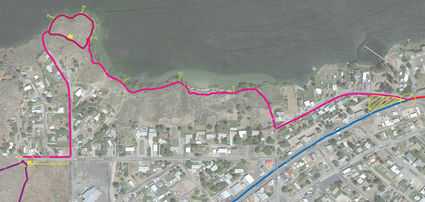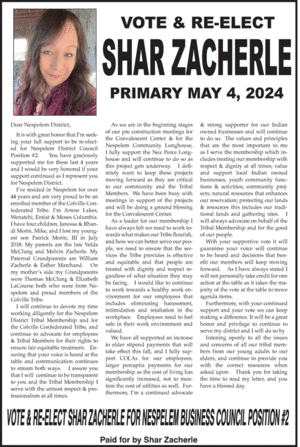Saturday pathways meeting will unveil plan so far
Public to get look at adjusted plan
Last updated 7/13/2016 at 10:12am

A proposed waterfront path (light) no longer cuts directly in front of some homes near the lake shore in an illustration in a draft planning document for Electric City's revitalization plan. A downtown path (dark) follows highway 155 through the core of the city. - Courtesy Electric City
Work on Electric City's Pathways and parks revitalization project could begin as early as late 2017, Councilmember Brad Parrish said.
Progress on the plan continues as the city prepares to hold its second public meeting on it, Saturday, July 16, at 1 p.m. in the park-like setting behind city hall.
Residents attending will get to see phase one of the planning process, with ideas taken from an earlier public meeting in May.
The meetings have been shaped by Russell Powers, deputy city clerk, and the progress on the plan will be presented by a team, including professors and students, from Washington State University's Rural Communities Design Initiative.
In talking about the project, Parrish said the revitalization plan would eventually become part of the city's comprehensive plan, making it possible to go after grant money.
A preview of the ideas coming out of the first public meeting show a walking trail featuring Ice Age Flood information, the development of the new park behind the fire station, and a park next to the arsenic treatment plant.
Parrish said when the plan is completed, the city can go after a variety of funds to make some of its goals happen. Sidewalks and curbing grants would be solicited from the Washington State Transportation Improvement Board. The city has already been talking to the TIB about a grant application. Parrish, who triggered the planning process, and got it through the council as a whole, said he hopes that something could get started in 2017, but definitely by 2018.
The city has committed to set aside some $400,000 from it hotel/motel tax fund to provide matching money to get the project started.
The council also set aside $40,000 to pay for the WSU groups expenses while designing the project, and for a plan by Gray & Osborne.
The proposed trail will avoid going in front of some housing, eliminating one of the sore points of an earlier plan, Powers said.
Overall, the trail and its Ice Age Flood information ultimately would become part of the Coulee Corridor that stretches from Othello to Omak, telling the story of how the region was shaped.
Other preliminary features of the plan include restrooms at both parks, a near full-size outdoor basketball court near the treatment plant, and a playground and picnic area in the park above the fire hall, with a fire pit and the planting of trees. This park idea was fostered by Councilmember Lonna Bussert.
In the first public meeting, a number of ideas surfaced of what residents wanted to see in the city. The second meeting will further shape these ideas, and the WSU team will eventually provide the city with a finished plan.
A local revitalization committee, made up of residents and two councilmembers, Parrish and Bussert, had recommended that the WSU planning group focus on the parks and trail ideas.
Sidewalks will be financed by the TIB grant, if the application is approved, and would not come under the hotel/motel tax part of any funding package.


Reader Comments(0)